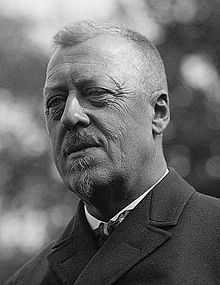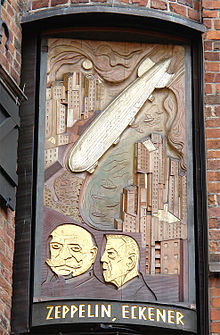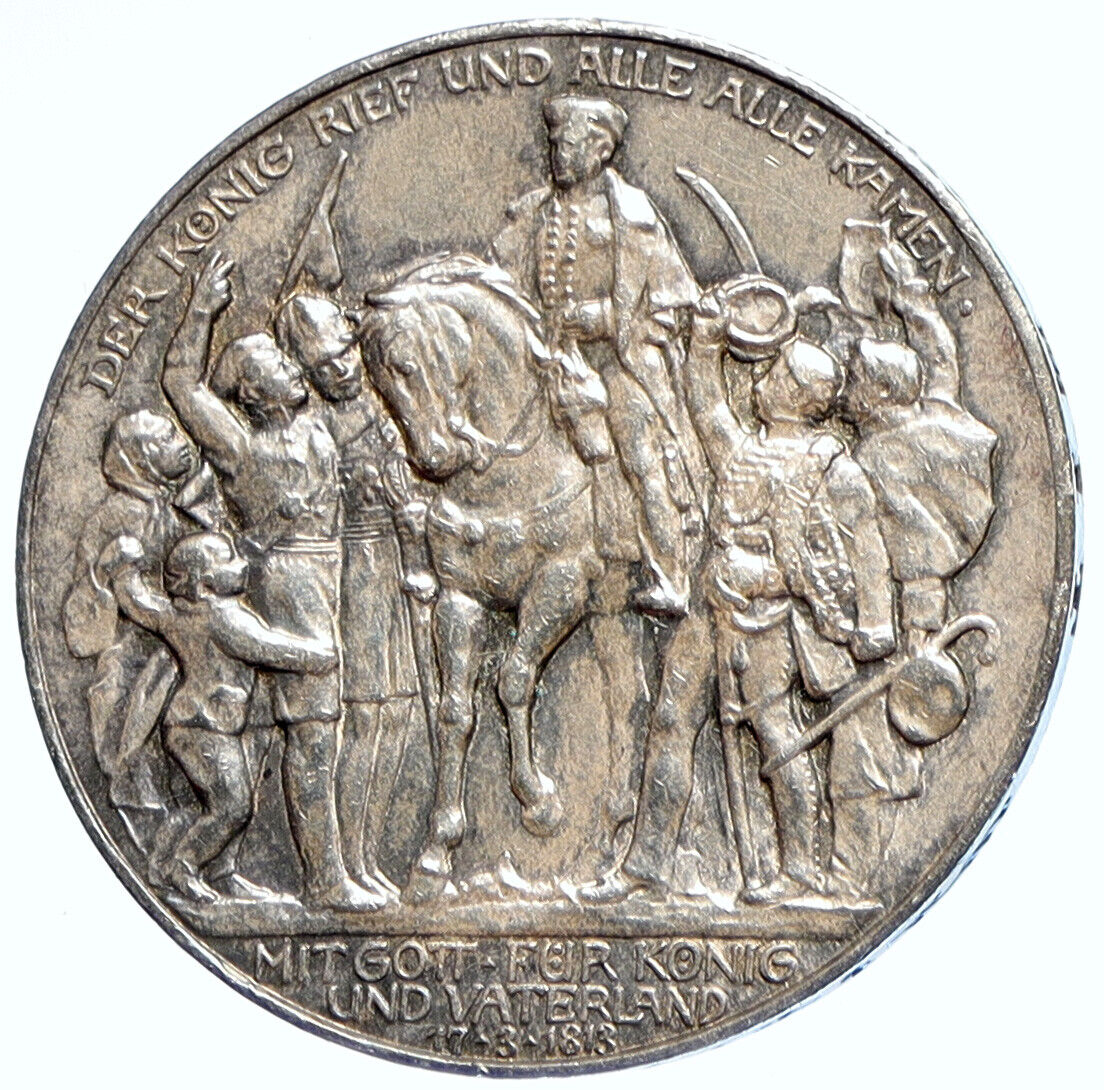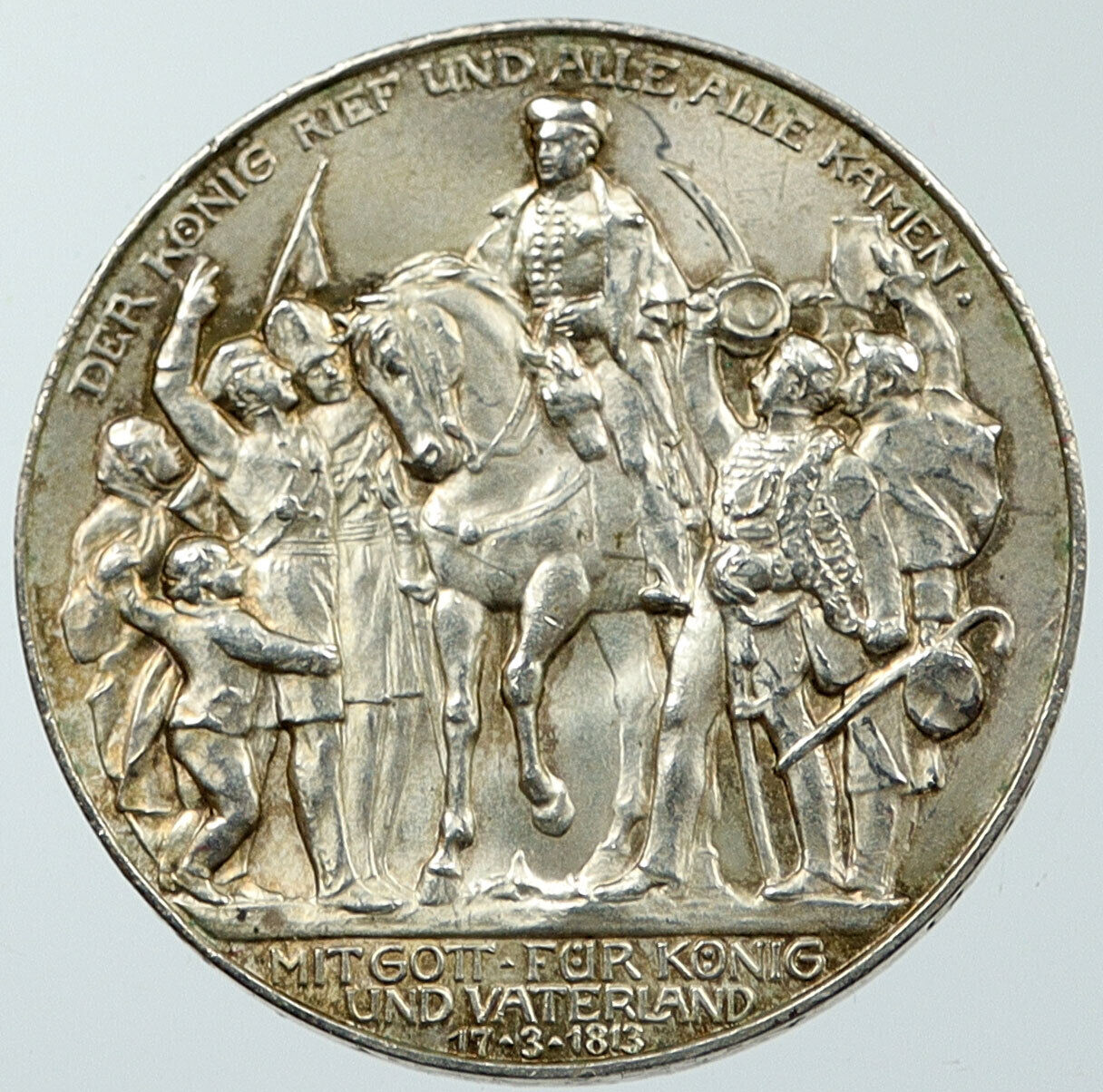|
Germany, Weimar Republic
Dr. Hugo Eckener Flight of German-made Zeppelin made for America
1924 Silver Medal 33mm (14.96 grams)
Dr. Hugo Eckener facing.
Zeppelin (the USS Los Angeles aka ZR-3) flying over land and water.
You are bidding on the exact item pictured, provided with a Certificate of Authenticity and Lifetime Guarantee of Authenticity.
The USS Los Angeles was a rigid airship, designated ZR-3, which was built in 1923-1924 by the Zeppelin company in Friedrichshafen, Germany as war reparation. It was delivered to the United States Navy in October 1924 and after being used mainly for experimental work, particularly in the development of the American parasite fighter program, was decommissioned in 1932.
Design
The second of four vessels to carry the name USS Los Angeles, the airship was built for the United States Navy as a replacement for the Zeppelins that had been assigned to the United States as war reparations following World War I, and had been sabotaged by their crews in 1919. Under the terms of the Treaty of Versailles Luftschiffbau Zeppelin were not permitted to build military airships. In consequence Los Angeles, which had the Zeppelin works number LZ 126, was built as a passenger airship, although the Treaty limitation on the permissible volume was waived, it being agreed that a craft of a size equal to the largest Zeppelin constructed during World War I was permissible.
The airship’s hull had 24-sided transverse ring frames for most of its length, changing to an octagonal section at the tail surfaces, and the hull had an internal keel which provided an internal walkway and also contained the accommodation for the crew when off duty. For most of the ship’s length the main frames were 32 ft 10 in (10 m) apart, with two secondary frames in each bay. Following the precedent set by LZ 120 Bodensee, crew and passenger accommodation was in a compartment near the front of the airship that was integrated into the hull structure. Each of the five Maybach VL I V12 engines occupied a separate engine car, arranged as four wing cars with the fifth aft on the centerline of the ship. All drove two-bladed pusher propellers and were capable of running in reverse. Auxiliary power was provided by wind-driven dynamos.
Operational history

Cover carried on the delivery flight from Germany to Lakehurst, New Jersey, October 12-15, 1924

Airship LZ-126 arriving at Lakehurst, 15 October 1924

Los Angeles (right) and Shenandoah moored in Hangar No. 1 in 1924
Los Angeles was first flown on 27 August 1924, and after completing flight trials began the transatlantic delivery flight on 12 October under the command of Hugo Eckener, arriving at the US Naval Air Station at Lakehurst, New Jersey after an 81-hour flight of 4,229 nautical miles (7,832 km). The airship was commissioned into the US Navy on 25 November 1924 at Anacostia, D.C. with LCDR Maurice R. Pierce in command. On its arrival in the United States, its lifting gas was changed from hydrogen to helium, which reduced payload but improved safety. At the same time the airship was fitted with equipment to recover water from the exhaust gases for use as ballast to compensate for the loss of weight as fuel was consumed, so avoiding the necessity to vent scarce helium to maintain neutral buoyancy.
The airship went on to log a total of 4,398 hours of flight, covering a distance of 172,400 nautical miles (319,300 km). Long-distance flights included return flights to Panama, Costa Rica and Bermuda. It served as an observatory and experimental platform, as well as a training ship for other airships.
On 25 August 1927, while the Los Angeles was tethered at the Lakehurst high mast, a gust of wind caught her tail and lifted it into colder, denser air that was just above the airship. This caused the tail to lift higher. The crew on board tried to compensate by climbing up the keel toward the rising tail, but could not stop the ship from reaching an angle of 85 degrees, before it descended. The ship suffered only slight damage and was able to fly the next day.
In 1929, the Los Angeles was used to test the trapeze system developed by the US Navy to launch and recover fixed wing aircraft from rigid airships. The tests were a success and the later purpose-built Akron-class airships were fitted with this system. The temporary system was removed from the Los Angeles, which never carried any aircraft on operational flights. In 1930, the Los Angeles also tested the launching of a glider over Lakehurst, New Jersey.
On 25 May 1932, the Los Angeles participated in a demonstration of photophone technology. Floating over the General Electric plant in Schenectady, New York, the crew of the ship engaged in an on-air conversation with a WGY radio announcer using a beam of light.
As the terms under which the Allies permitted the United States to have the Los Angeles restricted its use to commercial and experimental purposes only, when the U.S. Navy wanted to use the airship in a fleet problem in 1931 permission had to be obtained from the Allied Control Commission. The Los Angeles took part in Fleet Problems XII (1931) and XIII (1932), although as was the case with all U.S. Navy rigid airships, demonstrated no particular benefit to the fleet.
The Los Angeles was decommissioned in 1932 as an economy measure, but was recommissioned for a period after the USS Akron crashed in April 1933. Soon returned to storage, the airship was struck off the Navy list in 1939 and dismantled in its hangar, thus ending the career of the Navy’s longest serving rigid airship. Unlike the Shenandoah, Akron, and Macon, the Los Angeles’ career did not meet a disastrous end.
 Dr. Hugo Eckener (10 August 1868 – 14 August 1954) was the manager of the Luftschiffbau Zeppelin during the inter-war years, and also the commander of the famous Graf Zeppelin for most of its record-setting flights, including the first airship flight around the world, making him the most successful airship commander in history. He was also responsible for the construction of the most successful type of airships of all time. An anti-Nazi who was invited to campaign as a moderate in the German presidential elections, he was blacklisted by that regime and eventually sidelined. Dr. Hugo Eckener (10 August 1868 – 14 August 1954) was the manager of the Luftschiffbau Zeppelin during the inter-war years, and also the commander of the famous Graf Zeppelin for most of its record-setting flights, including the first airship flight around the world, making him the most successful airship commander in history. He was also responsible for the construction of the most successful type of airships of all time. An anti-Nazi who was invited to campaign as a moderate in the German presidential elections, he was blacklisted by that regime and eventually sidelined.
Background
.jpg/90px-Eckener_Haus_(Vorderansicht).jpg) Birth house Birth house
Eckener was born in Flensburg as the first child of Johann Christoph Eckener from Bremen and Anna Lange, daughter of a shoemaker. As a youth he was judged an “indifferent student”, and he spent summers sailing and winters ice skating.
Nevertheless, by 1892 under Professor Wilhelm Wundt, Eckener had earned a doctorate “magna cum laude” in what today might be deemed experimental psychology.2] at the University of Leipzig.
Eckener then began his military service in the Infantry Regiment 86 in Flensburg.
Eckener’s early career was as a journalist and editor; by August 1893 he was working for the Flensburger Nachrichten; in October 1897 he married Johanna, daughter of the publisher family Maaß. He later became a correspondent for the Frankfurter Zeitung[2] in 1905 and 1906, whilst writing a book on the social effects of capitalism.
Pre-war airship activities
Asked to cover the first flights of the Zeppelins LZ 1 and LZ 2, Eckener was critical of both airships’ marginal performances, but praised Count Ferdinand von Zeppelin’s dedication to his cause. Because several scientists and engineers had criticized his airship plans, the Count sought to speak to his critic and Eckener was so impressed by him that during October 1908 he agreed to be a part-time publicist for the Zeppelin Company. He became extremely interested in airships, and joined the company on a full-time basis.
His aptitude at flying was noticed early on in his career, and he became an airship captain, obtaining his airship license in 1911. However, when Eckener attempted his first flight on 16 May 1911 in the LZ 8, christened Deutschland II, he decided to launch it in a strong wind which pushed the craft into the hangar wall, damaging it seriously. Nonetheless, he became a very successful airshipman.
World War I
Eckener was responsible for training most of Germany’s airship pilots both during and after World War I. Despite his protestations, he was not allowed on operational missions due to his value as an instructor.
Head of the Zeppelin Company
 Eckener (marked with an x) test flying the LZ 126 in August before delivery to the United States in October 1924 Eckener (marked with an x) test flying the LZ 126 in August before delivery to the United States in October 1924
After the War, Eckener succeeded Count Ferdinand von Zeppelin, who had died on 8 March 1917. After considerable conflict with Zeppelin’s business manager, Alfred Colsman, who wanted to replace the production of airships with production of other (and likely more profitable) products, Eckener was able to keep the Zeppelin factory at Friedrichshafen on Bodensee (Lake Constance) in Württemberg, southern Germany, from being retooled. Colsman left the company soon afterwards.
The Treaty of Versailles had forbidden Germans to construct airships of the size needed to operate the profitable trans-Atlantic service that was Eckener’s goal. However, after much skilful lobbying, he persuaded the US and German governments to allow the company to build LZ 126, later rechristened the USS Los Angeles (ZR-3), for the US Navy as part of Germany’s war reparations. Eckener himself captained the airship on its delivery flight to Lakehurst, New Jersey. The Los Angeles became the longest-serving rigid airship ever operated by the US Navy.
The golden age of the rigid airship
 Russian polar researcher Rudolf Lazarevich Samoylovich (left) prior to leading the Graf Zeppelin’s scientific polar flight, with Eckener in Friedrichshafen, July 1931 Russian polar researcher Rudolf Lazarevich Samoylovich (left) prior to leading the Graf Zeppelin’s scientific polar flight, with Eckener in Friedrichshafen, July 1931
Refused funds by the penniless Weimar government, Eckener and his colleagues began a nationwide fund-raising lecture tour in order to commence construction of Graf Zeppelin, which became the most successful rigid airship ever built.
The first flight to America was fraught with drama. Near Bermuda on the outbound flight the airship was nearly lost after becoming caught in a severe storm during which fabric was ripped off the left fin. The ship was saved only by Eckener’s skilled piloting and the courage of his son, Knut Eckener, and other crew members who climbed out onto the fin to repair the damage. Upon arrival in America, a country which Eckener grew to love, he and the crew were subject to the first of two New York ticker tape parades.
Eckener captained Graf Zeppelin during most of its record-setting flights, including the 1928 first intercontinental passenger airship flight, the 1929 flight around the world (the only such flight by an airship, and the second by an aircraft of any type) and the 1931 Arctic flight.
 Cover autographed by Dr. Eckener flown on the nearly disastrous “Interrupted Flight” in May/August 1929. Cover autographed by Dr. Eckener flown on the nearly disastrous “Interrupted Flight” in May/August 1929.
A master of publicity as well as a master airship captain, Eckener used the Graf Zeppelin to establish the Zeppelin as a symbol of German pride and engineering.
After these flights the public treated Eckener as a national hero. During the early 1930s, Eckener was one of the most well-known and respected figures in Weimar Republic Germany. In the 1932 presidential election Eckener was a potential unity candidate against Adolf Hitler, encouraged to campaign by leaders of both the SPD and the Zentrum, but he bowed out when Paul von Hindenburg decided to run for a second term. However, his potential candidacy had already angered the Nazi party. In supposed anger and fear of Eckener, Hitler’s de facto deputy, Hermann Esser, once called him the “director of the flying weisswurst”, a greyish-white Bavarian sausage.
Sidelined
The Nazis came to power in January 1933. A planned arrest of Eckener in 1933 was blocked by Hindenburg. Hitler met Eckener only one time, in July 1933, but the two barely spoke. Eckener did not make any secret of his dislike of the Nazis and the disastrous events he foresaw. He criticised the regime frequently, and refused to allow the Nazis to use the large hangars at Frankfurt for a rally. Eventually the Nazis declared Eckener to be persona non grata and his name was no longer allowed to appear in print.
During the 1930s, the Nazi government nationalized the Zeppelin operation under the name Deutsche Zeppelin-Reederei GmbH (DZR). The Nazis sidelined Eckener in favour of men who were more compliant with their wishes. In their haste to please the Nazi regime, these newly promoted airshipmen did not always obey Eckener’s safety procedures. For example, the maiden voyage of the Hindenburg nearly resulted in disaster when Captain Ernst Lehmann brought the ship out in strong winds in order to undertake a Nazi propaganda flight. The ship was damaged, and there was an argument between Eckener, Lehman and the Nazi propaganda ministry.
Hugo Eckener had always made safety his absolute priority during his many years managing airship operations. With Eckener’s management, the Zeppelin company had a perfect safety record with no passenger ever sustaining a serious injury on any of the more than 1 million air miles that the rigid airships flew, until the Hindenburg disaster of 1937.[citation needed]. Eckener was in Graz, Austria when he heard news of the Hindenburg disaster on 6 May 1937. In the official inquiry he concluded that a static spark ignited leaking hydrogen in the aft section of the ship. The leak would have been caused by a sharp turn, which he believed overstrained a bracing wire, causing it to snap and rip open an adjacent gas cell.
After the destruction of the Hindenburg, the nearly-completed LZ-130 Graf Zeppelin was redesigned as a helium-filled ship, although, owing to geo-political considerations, the American helium was not available.[citation needed]. Thus the ship never began commercial service. However, under the command of Captain Albert Sammt, who had previously survived the fiery destruction of the Hindenburg, albeit with severe burns, the ship performed an espionage mission off the coast Great Britain, intended to investigate the radar defences. Eckener, however, had by this time little influence on the Zeppelin Company.
After World War II
Eckener survived World War II despite his disagreements with the Nazis. Post war, he was involved in a plan by the Goodyear Zeppelin Corporation to build large rigid airships. However, nothing came to pass of this project.
In 1945, Johannes Weyl and Eckener co-founded the Südkurier regional newspaper and Eckener started writing for German-French co-operation. In November 1945 Eckener was confronted with the charge of collaboration with Nazi Germany. In 1947 the French occupying powers fined him 100,000 German Reichsmarks. Many personalities lobbied for Eckener’s rehabilitation. The judgement was rejected in July 1948 and Eckener was rehabilitated.
Eckener’s home town of Flensburg had a Danish-oriented majority in its council since 1945, with the goal of unification with Denmark. Eckener remained active in local politics campaigning for a German majority in Flensburg, while at the same time, during a “thundering” one-hour speech in 1951, warning against small-mindedness in border concerns.[1]
Eckener died in Friedrichshafen on 14 August 1954 just after his 86th birthday.
Legacy
 Das Haus des Glockenspiels in Bremen’s Böttcherstraße displays this panel as part of 10 from Bernhard Hoetger’s 1934 “ocean-crossing” set Das Haus des Glockenspiels in Bremen’s Böttcherstraße displays this panel as part of 10 from Bernhard Hoetger’s 1934 “ocean-crossing” set
Eckener was responsible for many innovative aviation developments, notably the trans-Atlantic passenger services offered by the airships Graf Zeppelin and Hindenburg. Together with his chief designer, Dr. Ludwig Dürr, he was responsible for developing the rigid airship to near-perfection for the time.
Since his death his achievements have been remembered by airship enthusiasts and historians. Additionally, the town of Friedrichshafen, scene of his many triumphant homecomings in Graf Zeppelin, has recognised his memory by naming a large new conference centre after him.
 Germany, officially the Federal Republic of Germany, officially the Federal Republic of  Germany is a federal parliamentary republic in western-central Europe. It includes 16 constituent states and covers an area of 357,021 square kilometres (137,847 sq mi) with a largely temperate seasonal climate. Its capital and largest city is Berlin. With 81 million inhabitants, Germany is the most populous member state in the European Union. After the United States, it is the second most popular migration destination in the world. Germany is a federal parliamentary republic in western-central Europe. It includes 16 constituent states and covers an area of 357,021 square kilometres (137,847 sq mi) with a largely temperate seasonal climate. Its capital and largest city is Berlin. With 81 million inhabitants, Germany is the most populous member state in the European Union. After the United States, it is the second most popular migration destination in the world.
Various Germanic tribes have occupied northern Germany since classical antiquity. A region named Germania was documented before 100 CE. During the Migration Period the Germanic tribes expanded southward. Beginning in the 10th century, German territories formed a central part of the Holy Roman Empire. During the 16th century, northern German regions became the centre of the Protestant Reformation.
The rise of Pan-Germanism inside the German Confederation resulted in the unification of most of the German states in 1871 into the Prussian-dominated German Empire. After World War I and the German Revolution of 1918-1919, the Empire was replaced by the parliamentary Weimar Republic. The establishment of the Third Reich in 1933 led to World War II and the Holocaust. After 1945, Germany split into two states, East Germany and West Germany. In 1990, the country was reunified.
 In the 21st century, Germany is a great power and has the world’s fourth-largest economy by nominal GDP, as well as the fifth-largest by PPP. As a global leader in several industrial and technological sectors, it is both the world’s third-largest exporter and importer of goods. Germany is a developed country with a very high standard of living sustained by a skilled and productive society. It upholds a social security and universal health care system, environmental protection and a tuition free university education. In the 21st century, Germany is a great power and has the world’s fourth-largest economy by nominal GDP, as well as the fifth-largest by PPP. As a global leader in several industrial and technological sectors, it is both the world’s third-largest exporter and importer of goods. Germany is a developed country with a very high standard of living sustained by a skilled and productive society. It upholds a social security and universal health care system, environmental protection and a tuition free university education.
Germany was a founding member of the European Union in 1993. It is part of the Schengen Area, and became a co-founder of the Eurozone in 1999. Germany is a member of the United Nations, NATO, the G8, the G20, and the OECD. The national military expenditure is the 9th highest in the world. Known for its rich cultural history, Germany has been continuously the home of influential artists, philosophers, musicians, sportsmen, entrepreneurs, scientists and inventors.
|








 Dr. Hugo Eckener (10 August 1868 – 14 August 1954) was the manager of the Luftschiffbau Zeppelin during the inter-war years, and also the commander of the famous Graf Zeppelin for most of its record-setting flights, including the first airship flight around the world, making him the most successful airship commander in history. He was also responsible for the construction of the most successful type of airships of all time. An anti-Nazi who was invited to campaign as a moderate in the German presidential elections, he was blacklisted by that regime and eventually sidelined.
Dr. Hugo Eckener (10 August 1868 – 14 August 1954) was the manager of the Luftschiffbau Zeppelin during the inter-war years, and also the commander of the famous Graf Zeppelin for most of its record-setting flights, including the first airship flight around the world, making him the most successful airship commander in history. He was also responsible for the construction of the most successful type of airships of all time. An anti-Nazi who was invited to campaign as a moderate in the German presidential elections, he was blacklisted by that regime and eventually sidelined..jpg/90px-Eckener_Haus_(Vorderansicht).jpg) Birth house
Birth house  Eckener (marked with an x) test flying the LZ 126 in August before delivery to the United States in October 1924
Eckener (marked with an x) test flying the LZ 126 in August before delivery to the United States in October 1924  Russian polar researcher Rudolf Lazarevich Samoylovich (left) prior to leading the Graf Zeppelin’s scientific polar flight, with Eckener in Friedrichshafen, July 1931
Russian polar researcher Rudolf Lazarevich Samoylovich (left) prior to leading the Graf Zeppelin’s scientific polar flight, with Eckener in Friedrichshafen, July 1931  Cover autographed by Dr. Eckener flown on the nearly disastrous “Interrupted Flight” in May/August 1929.
Cover autographed by Dr. Eckener flown on the nearly disastrous “Interrupted Flight” in May/August 1929.  Das Haus des Glockenspiels in Bremen’s Böttcherstraße displays this panel as part of 10 from Bernhard Hoetger’s 1934 “ocean-crossing” set
Das Haus des Glockenspiels in Bremen’s Böttcherstraße displays this panel as part of 10 from Bernhard Hoetger’s 1934 “ocean-crossing” set  Germany, officially the Federal Republic of
Germany, officially the Federal Republic of  Germany is a federal parliamentary republic in western-central Europe. It includes 16 constituent states and covers an area of 357,021 square kilometres (137,847 sq mi) with a largely temperate seasonal climate. Its capital and largest city is Berlin. With 81 million inhabitants, Germany is the most populous member state in the European Union. After the United States, it is the second most popular migration destination in the world.
Germany is a federal parliamentary republic in western-central Europe. It includes 16 constituent states and covers an area of 357,021 square kilometres (137,847 sq mi) with a largely temperate seasonal climate. Its capital and largest city is Berlin. With 81 million inhabitants, Germany is the most populous member state in the European Union. After the United States, it is the second most popular migration destination in the world. In the 21st century, Germany is a great power and has the world’s fourth-largest economy by nominal GDP, as well as the fifth-largest by PPP. As a global leader in several industrial and technological sectors, it is both the world’s third-largest exporter and importer of goods. Germany is a developed country with a very high standard of living sustained by a skilled and productive society. It upholds a social security and universal health care system, environmental protection and a tuition free university education.
In the 21st century, Germany is a great power and has the world’s fourth-largest economy by nominal GDP, as well as the fifth-largest by PPP. As a global leader in several industrial and technological sectors, it is both the world’s third-largest exporter and importer of goods. Germany is a developed country with a very high standard of living sustained by a skilled and productive society. It upholds a social security and universal health care system, environmental protection and a tuition free university education.




